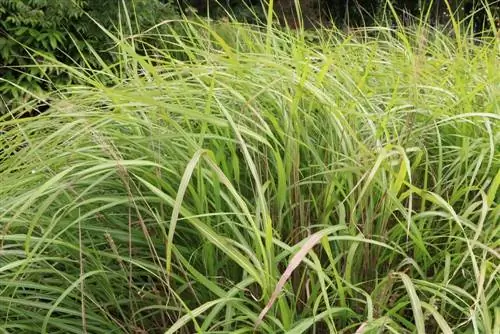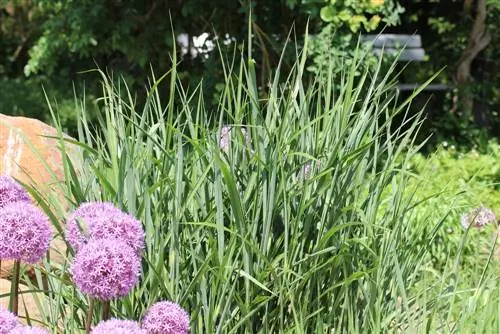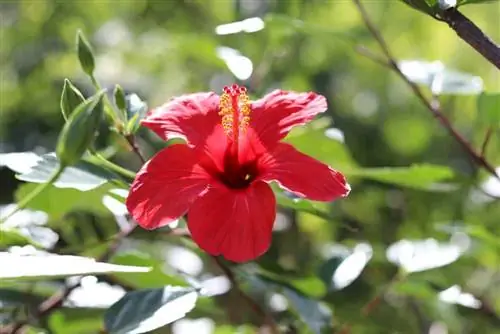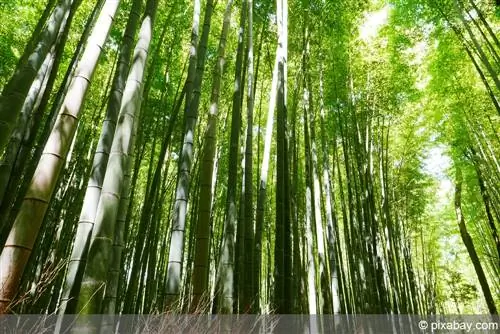- Author admin [email protected].
- Public 2023-12-17 03:39.
- Last modified 2025-01-24 12:45.
Giant Miscanthus (Miscanthus Giganteus) in German “large stem flower grass” belongs to the family of sweet grasses. As the name suggests, this perennial plant is characterized by rapid growth of up to 5 cm per day. It reaches an astonishing height of up to four meters in a short time. This makes the plant one of the largest of its kind.
Giant reed is now increasingly being used as an energy plant because of its rapid growth.
Appearance of Miscanthus Giganteus
This ornamental grass grows densely and tall, impresses with its light and transparent appearance and is extremely robust. So it can be used excellently as a natural privacy screen in open borders or pebble beds. When growing it is light green with a white midrib and in autumn the leaves take on a golden yellow color. Winter gives the grass with hoarfrost a fairytale, graceful look.
Giant miscanthus location
Sunny to partially shaded places are particularly suitable for miscanthus. The plant likes moist, humus-rich clay soil that is not prone to waterlogging and contains little sand.
- Location as sunny as possible.
- light shade is well tolerated.
- a lot of shade creates weak growth and little flowering.
- moist, deep soil without waterlogging.
Planting tips
Sowing should take place at a soil temperature of 20°C, the soil must be kept moist. If the plant forms leaves after a germination period of at least three weeks, it can be planted out in May. Young plants also prefer to be planted outdoors during this time. The planting distance should not be less than one meter. The grass forms rhizomes, i.e. long horizontal roots that form new seedlings at a distance from the mother plant. There is no need for a rhizome barrier as the roots do not grow wildly.
- nutrient-rich and humus-rich soil
- Enriching the soil with compost increases the moisture content
- moist but slightly permeable soils are ideal
- the drainage should be as permeable as possible
- stagnant moisture damages the plant
- compacted soil structure is unfavorable
- maintain at least one meter planting distance
- Miscanthus can be combined well with phlox, sunflower or torch lilies
- Regular weed picking is mandatory for new planting
- Rhizome barriers against miscanthus are only necessary in adjacent, high-maintenance green areas
Giant Miscanthus Care
Miscanthus is easy to care for. To plant it, you should water it daily for three months. After that, this is only necessary when it is dry. You can safely avoid fertilization, the plant grows completely adequately without artificial nutrients. Young plants need at least two summers to bloom. Flowering time is September after warm summer months. The grass is hardy and insensitive to frost and cold. Cutting back to around 10 cm should only be done in spring when the days get warmer again. The dry, above-ground leaves ensure adequate winter protection. In addition, the nutrients migrate back into the roots, which ensures strong growth in spring.
- freshly planted reeds, water young plants plenty and sufficiently
- Soil should always be moist
- fertilization is only necessary in nutrient-poor soils
- young plants must not be fertilized
- Pruning in spring 10 cm above ground level - pruning in autumn leads to rot
- is sufficiently hardy
- tie leaves and stalks together to protect against wind and snow loads in winter
Giant Reed Propagation
Propagation is recommended in the spring after pruning by dividing the clumps with a spade. You dig up the divided grass and immediately plant it somewhere else so that new roots can quickly take root here. Self-sowing is only possible in radiation-rich locations in autumn.
- March, April by division of the rhizomes
- September through self-sowing after a sunny summer
Avoid care errors

Weeds are poisonous to Chinese reeds in the year they are planted. So pull weeds regularly to guarantee the best possible start to planting. You should ensure that the plant is sufficiently declared in order to receive specific information about the variety of Chinese grass. Also important: Always pay attention to the space required by the perennial so that it can spread comfortably according to its type. A maximum of four plants per square meter with a distance of half a meter between each other is a golden rule.
- Flowers: beige or strong reddish brown, feather-like, large flower spikes, usually only appear in very warm summers
- Flowering period: September to November
- Leaf: arched overhanging, yellow, light brown autumn color, broad-leaved
- Growth: strong, upright growth, forming clumps
- Growth size: up to 4 meters high, up to 2 meters wide
- Location: sunny-partly shade
- Soil: loamy-humous, fresh, loose soil in which the plant can spread easily
- Special feature: fast, strong growth after every pruning
- Winter hardiness: very frost hardy and cold resistant
- Use: privacy plant, solitary plant, windbreak, hedge plant, border of ponds, as a potted plant in dry gardens, leading perennial in mixed planting
- Space requirement: 1-3 pieces per square meter, row planting; 2-4 pieces per running meter
- Life expectancy: at least 20 years with little maintenance required
What you should know about giant miscanthus in brief
Giant Chinese grass looks extremely decorative as a summer green solitary plant as well as in a row as a view and windbreak. It grows quickly and upright, has impressive reed-like foliage and is really easy to care for and hardy. In combination with evergreen perennials and trees, it is ideal for creating ponds and ponds and enriches every garden with its graceful and accentuated growth. As a dry plant, it can serve as an insect hotel for wild bees or be tied into mats for wind and sun protection. It also looks good as a potted plant on a balcony or terrace. Miscanthus becomes more and more expressive in the color and structure of the leaves and flowers over the years.
Using Giant Miscanthus
The Miscanthus has a variety of uses:
- It is suitable as an excellent privacy screen when planted closely.
- Smaller varieties are often used as background or border plants in woody and perennial borders.
- Even agricultural use as fiber for paper, pot and plate production is possible.
There are many different varieties. So they differ considerably in size. While the M. sin 'Yakushima Dwarf' only grows to a height of 100 cm, M.floridulus up to 300 cm. The leaf shape also has something to suit almost all tastes. There are varieties with white colored leaves (“Variegatus”), with yellowish striped leaves (“Zebrinus”), those with a silver groove (“Silberfeder”), but also reddish colored leaves (“Dronning Ingrid”). The spikes bloom in silver-white, brownish or reddish colors. But there are also some varieties that don't bloom here, such as the giant reed or the eulalias grass.
The benefits of miscanthus are not limited to its decorative function in your garden. He also gives you some material for flower decorations in the house: you can cut off his inflorescences and use them like cut flowers, and the reeds themselves also hold up quite well in the vase and can be used as a basis for many magical floristic works of art. The remains of your miscanthus, which are cut in spring, are chopped and then produce an excellent peat substitute, which gives the potting soil of your houseplants the necessary permeability. If you have a lot of this beautiful reed plant in your garden, it is probably worth checking whether the chaff of your variety, like that of Miscanthus giganteus, can be used for mulching or as bedding for a variety of pets.
What should be considered when growing and caring for miscanthus
- The easy-care miscanthus could get into trouble if the soil is very compacted, so you should plan a season of green manure beforehand.
- As I said, miscanthus, which comes from swamps and damp meadows, prefers slightly moist soil, so new plants in particular need to be watered additionally if in doubt.
- The young plants are initially sensitive to competition, so weeds should be controlled carefully.
- If miscanthus feels really good, it can also have its disadvantages: After a few years, it forms extensive rhizomes that produce new plants all around.
- This can be quite critical. If you want the Miscanthus to stay in its place permanently, you should consider putting it in the ground in a mortar bucket.
- If a Chinese reed spreads in the wrong place, you can usually stop it if you continually cut it down to the ground, then it no longer has any energy left for rhizome formation.






